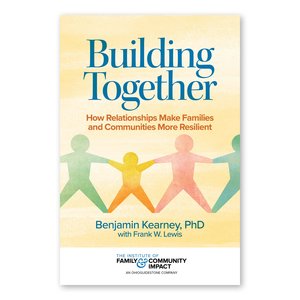This Story About Elephants Can Teach Us About Building Stronger Human Communities

From the introduction to
Building Together: How Relationships Make Families and Communities More Resilient
In the 1990s, endangered white rhinos living in South Africa’s Pilanesberg Park were turning up dead. Savagely murdered, in fact. But their horns were intact, which meant this was not the work of poachers. As 60 Minutes would later explain in a segment titled “The Delinquents,” rangers determined that the killers were adolescent male elephants.
These elephants had been born in another preserve, Kruger National Park, but the elephant population there had grown too large. At the time there was no way to transport adult elephants, so the keepers made a fateful decision: to kill the adults and relocate the youngest. The government veterinarian who approved it lamented that there was no other option.
The problem was that this ruined the elephants’ socialization processes.
Adult male and female elephants live in separate herds, and the young spend their first ten years with their mothers, aunts, and grandmothers. These older female elephants socialize the young and teach them life skills, like finding water holes and where the bones of their ancestors lie. After ten years, the young females begin to participate in raising the next generation, and the males are sent to live with the herd of adult males. They then go through another socialization process, with their fathers and uncles, and at around age twenty, they may assume leadership roles in that herd and procreate.
When the young, orphaned elephants were delivered to Pilanesberg Park, they were cut off from this process. Eventually a teenage male named Mafuto organized his fellow misfits into their own herd. Their campaign against the rhinos began as harassment—and it was almost comical, because the elephants were so small. But as they grew, and as hormones kicked in, their behavior escalated. Their attacks eventually claimed the lives of thirty-nine rhinos, 10 percent of the park’s population.
Mafuto was put down, but the rangers were able to find another option for the rest. Using new, specially designed trucks, they brought in fully grown male elephants, who quickly established a new hierarchy. The rhino murders stopped. The 60 Minutes report likened the solution to father figures confronting a gang of teenage boys who have been terrorizing their neighborhood.

I first heard this story at a conference for therapists in a presentation by Darcia Narvaez, a professor of psychology at the University of Notre Dame and an expert on moral development. Dr. Narvaez doesn’t study elephants, but her interests and influences range across disciplines and she relayed the story to make an important point about humans: We are more like our mammalian kin than we realize. We share not just physical characteristics like organ systems and the need to sleep, but behaviors, both inherited and learned. The most important shared attribute, the one that separates mammals from all other creatures on the planet, is our reliance on attachment to others of our species.
Elephant and other mammal communities serve the same function for their young as human communities do for babies—to mold them into mature, socialized adults. When that process breaks down, the socialization process is interrupted and the animal, or human, grows up isolated, mistrusting, and, often, aggressive. The documentary Blackfish tells the sad story of Tilikum, a killer whale captured as a juvenile for SeaWorld, who later injured and killed trainers.
Among humans, the effects of isolation are felt not just by individuals but by groups. We did not evolve from lions and cheetahs, living largely solitary lives. We are much more like chimpanzees, who live in clans. And like chimps, we can organize quickly into hierarchical tribes primed for conflict with other groups. This is an important trait, but it’s not a healthy state for us and, when it’s prolonged, it takes a toll. Once on a war footing, the tribe spends less time nurturing its young and building relationships, and the sense of community breaks down.
Experience does indeed shape who we become, but there are biological processes at play as well, many of them inherited from and shared with our mammalian kin, and we can no longer ignore biology if we are to help people affected by stress and trauma.
If we could examine the brains of the Pilanesberg Park elephants with the technology available today, we would almost certainly find abnormalities in the sizes of certain structures and their capacities to communicate with each other. These abnormalities would likely be consistent across all the members of the elephant gang, who had different sets of parents. Why? Because experience changes the very architecture of the brain—the hardwiring, as we often call it—and negative experiences force changes that compel detrimental behavior. Experience influences biology, and biology influences experience in equal measure in all mammals, including humans.
We used to believe that we could not grow new brain cells, which are called neurons. As an undergraduate in the 1980s, I was taught that the brain is a black box, that we are born with nothing except a few impulses, and that experience dictates virtually everything about us. Thanks to amazing advances in neuroscience, we now know that none of this is true. Experience does indeed shape who we become, but there are biological processes at play as well, many of them inherited from and shared with our mammalian kin, and we can no longer ignore biology if we are to help people affected by stress and trauma.
In humans, 80 percent of brain development occurs in the first four years. There are additional bursts at adolescence and in early adulthood, but the foundation for the advances in verbalization, logic and emotion processing, empathy, and everything else that we rely on to function in a complex society is laid before the age of five. And that process begins at birth.
There are about 100 billion neurons in your brain with as many as 100 trillion connections, called synapses, between them. The most rapid growth of synapses occurs between birth and age three, but new connections are formed and pruned away throughout our lives, and experience drives all of it. In his book Behave: The Biology of Humans at Our Best and Worst, Dr. Robert Sapolsky describes what would happen if you were to wear an eye patch for a few days: Almost immediately, the neurons in your auditory processing area would start sprouting dendrites (the fibers through which neurons connect) to reach to the visual center, to help compensate for the lack of visual information. Take away the eye patch, and those dendrites would stop spreading and eventually will be pruned back because they aren’t needed.
Moreover, the brain will organize itself to respond quickly, even if learned responses are inappropriate and detrimental. Uncommon experiences build the synaptic equivalents of dirt roads, inefficient and easily lost if not used. Recurring experiences turn those paths into paved roads and eventually superhighways, designed for speed, volume, and durability. The brain of a child growing up in a stressful environment will build synaptic superhighways around their capacities to respond to anxiety instead of around learning to regulate their own emotions and to forge bonds with other people. If untreated, the child will carry this burden into adulthood and quite likely pass similar traits onto his or her own children through behavior and, as we’ll discuss later, through DNA.

Evolution has given us the most complex brain on the planet, and we’ve used it to do marvelous things.
… Can we learn to use it to touch each other’s hearts and open each other’s minds? Can we learn how to build a better future together?
At OhioGuidestone, we believe that we are not just helping parents, children, and infants. We are helping their communities and their future offspring. That’s why it’s so vitally important that we help them make changes in their lives today. The damage is not necessarily permanent. The key to preventing and possibly reversing it is relational attachments with other people. And all of us have roles to play.
Positive experiences compensate for stress in childhood. When a child’s experiences are healthy, vibrant, and enriching, in an environment that is rich in opportunities for exploring and social play, the child’s response systems are strengthened. The architecture and chemistry of the brain change, reversing the effects on stress hormone output, and helping the child return to baseline on his or her own.
Prevention is more effective than treatment, and so the earlier we can get involved in children’s lives, the better. OhioGuidestone believes:
- Toxic stress resulting from abuse, neglect, poverty, and other chronic conditions interferes with the neurobiological processes through which children learn to regulate themselves and form bonds with others.
- We can prevent, mitigate, and sometimes even reverse the damage with intuitive, noninvasive, and relatively inexpensive interventions that help children and caregivers build stronger, healthier bonds.
- These interventions can improve physical health, strengthen families, and build more stable and cooperative communities in the near and distant future.
We have identified eight elements that are key to delivering impact to families in need:
- Belonging to a social network that encompasses a “we” perspective rather than a self-defining one, such as “us vs. them.”
- Belonging to a social network that has a shared altruistic vision.
- Belonging to a nurturing home.
- Engaging in an early-enhanced reading environment.
- Building and enhancing resiliency.
- Engaging in nurturing relationships and therapeutic support.
- Limiting exposure to “artificial joy,” like addictions.
- Addressing the interconnection of mental and physical health.
It’s a comprehensive list, to be sure. There are no quick fixes. But all these interventions are powered by a few universally recognized and inexhaustible forces. Chief among them is joy. When we combat adverse childhood experiences and toxic stress responses, all our interventions must be relational, and must lead to joy. That joy process changes the understanding of social-emotional relationships and lessens the impact of toxic stress.

When we build joy processes, we don’t need so many rules. Children are more likely to behave when they experience sufficient joy and care in their lives. So we need to equip families with the capacity to find more joy. The rest will follow; as group mammals, we are hardwired to develop social connectedness. We want to be loved and to love. We just have to be shown how.
This book is not just for therapists. We hope that those who make the funding and policy decisions that determine where and how resources are deployed, and indeed everyone who wants stronger, more resilient families and communities, will heed the message. Neuroscience has advanced more in the past decade than in the previous century. It’s time for everyone in a position to help families to catch up. Evolution has given us the most complex brain on the planet, and we’ve used it to do marvelous things—to touch the face of God, as the poet John Gillespie Magee Jr. once described the miracle of flight. Can we learn to use it to touch each other’s hearts and open each other’s minds? Can we learn how to build a better future together?
“Building Together develops a clear and compelling case for change by drawing upon a diverse set of disciplines, including ethology, sociology, psychology and neuroscience. Anyone who cares for children, their families or their communities will benefit from Building Together.”
— Andrew Garner, MD, PhD, FAAP Clinical Professor of Pediatrics, CWRU School of Medicine, and co-author of Thinking Developmentally: Nurturing Wellness in Childhood to Promote Lifelong Health





